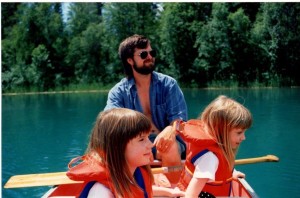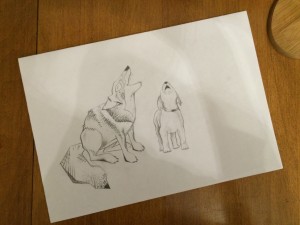Once upon a time, in a land not far away, there was a kingdom that was ruled by a king who had four children.
The children were all of an age to rule, and in this kingdom the crown was passed when the king chose to give it rather than when he died and to the child who most deserved it rather than to the firstborn. It was a very peaceful kingdom in a peaceful land that had never known fear (though rumours of fearful things were heard of from other lands).
The health of the king was strong, so, while his hair grew white and his fingers gnarled, he showed no signs of dying nor of feeling the need to give his throne to a younger ruler. His children were all even-tempered people with good heads on their shoulders and good hearts in their chests, but they felt their youth and opportunity for doing great deeds as kings or queens slipping away, and so – without desiring to do any harm – they wondered if they might not be able to hurry the process up a bit. To this end, one Sunday afternoon, they gathered in their castle library to talk.
“If only there was some trouble in our land!” The firstborn said from his leather chair. “Trouble that would make us need to go to battle, that would call for a younger ruler to helm the nation and to save our people from disaster!… or something.”
His siblings, two young men and a woman, agreed that it would be nice if there was such a thing (though they had never witnessed it).
The youngest prince piped up. “What if we caused a little trouble?” he said. “Nothing serious, of course, and we would do it secretly; but what if we introduced a little worry to the kingdom so that our father would feel the need to pass on the throne? Surely our goal would be reached, and the new king or queen could stamp out the problem easily enough when they were crowned!”
The others thought this was a great idea, and each suggested a way to bring it about. Because he had had the initial thought, the youngest went first. He suggested that, as Christmas was coming, they could tie a chicken to the tail of each of the postmaster’s horses on Christmas Eve so that the horses would be so worried that they wouldn’t be able to deliver the presents on time. This idea brought about chuckles, but the eldest said it was cruel, and the wings of the thought were clipped before it could take flight. His own idea, however, was similarly useless, as was the young lady’s, so that before they knew it there was only one chance left for the plan to work.
The third son, the second born, simply told a story, and asked his siblings to observe the effect; and it was a terrible tale, full of death and dismemberment. By the time he was finished, the others felt so ill and fearful that they decided that he, undoubtedly, had the key to introducing the trouble that they were seeking. They also noted thankfully that it was just a story, and decided that it could be published anonymously in the kingdom’s newspaper, that everyone would read it, that many of the citizens would feel ill and not show up for work the next day and that the king would receive many postcards expressing concerns about national security and then the matter would be done with.
So they published the story, and it worked like a charm. What they had predicted happened, and the king received so many messages asking that he give his throne up to an heir who, with youthful energy, would be able to handle the things that the story described in case they came true that he selected his daughter for the throne and before the week was out she received her crown. All of the others were happy about this (except the second-born, who was never the same after the session in the library).
The problem was that the people did not forget the story, and it had a much larger effect than anticipated. The new queen and her citizens were so harried by the fears that it had raised that the council of governors felt obliged to craft a new law in an effort to prevent the things which were written of from taking place. They decreed that anyone exhibiting characteristics that were not normative to the people in that land should not be allowed past their borders, whatever their situation may be, since their land had never had any events such as were written about in the story before and so if they were likely to come they were likely to come from without (they thought).
Fear had entered the kingdom, and it came in the form of a story.
Have you ever thought that a story could have so much power?
You’ve just read a tale that was adapted from Leslie Silko’s piece about the witches that brought evil into the world as related by Thomas King in his book The Truth About Stories: A Native Narrative (9-10). The original story can be found in Silko’s Ceremony.
After writing this piece, I told it orally to friends and family and observed what took place. As I told it the first time, I found myself changing the tale to increase the amount of logical sense that it made. This was an interesting discovery. I also began incorporating words and phrases that suited the genre and setting of my story even if I hadn’t had them in the written version. These factors said to me that a story reflects the culture and values of the person from whom it issues, which means that oral literature may change from generation to generation in order to stay relevant to its people.
It seems to me that while there are upsides to the written word, the ability of an (primarily) oral story to change is a great boon to the culture to which it belongs. To illustrate this point, don’t you think it’s strange and probably detrimental to our youth that Western school systems continue to teach classic literature even though many of the values represented by it are no longer relevant in our world? Don’t you think that this must confuse our kids?
Another thing that I noticed as I told my story was that the person to whom I was telling it influenced the telling HUGELY. Like, MUCH more than I had imagined it would. Storytelling is clearly an art unto itself. For example, some audiences made me very nervous, which made me less expressive, and less expressiveness made the story less engaging; some audiences felt better suited to the way that I had crafted the tale, and this made me more comfortable and excited, which made the story more successful; and, no matter who I was speaking to, the parts that I emphasized most were dependent on the personality of the listener and what I thought they would like.
Overall, I feel that telling memorized stories in a skillful way to varying audiences is a thing that takes a lot of practice. Some performers make it look so easy; but it clearly isn’t!
Works Cited
Grimm, Jacob, and Wilhelm Grimm. Trans. Edgar Taylor and Marian Edwardes. Ed. Authorama. “The Robber Bridegroom.” Fairy Tales by the Grimm Brothers. Authorama, n.d. Web. 31 Jan. 2015. <http://www.authorama.com/grimms-fairy-tales-23.html>.
King, Thomas. The Truth about Stories: A Native Narrative. Minneapolis: U of Minnesota, 2005. Print.
Silko, Leslie Marmon. Ceremony. New York, N.Y.: Penguin, 1986. Print.
Expert Village. “Singer Songwriter Performance Tips: Stage Presence Tips: Story Exercise.” Online video clip. YouTube. YouTube, 17 Oct. 2008. Web. 31 Jan. 2015. <https://www.youtube.com/watch?v=xdWdHp7z3xE>.


Recent Comments